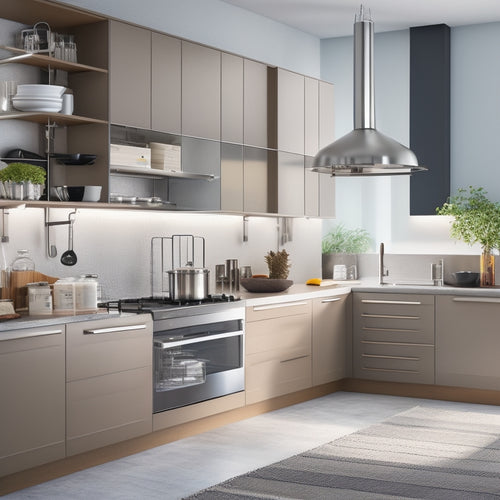
Closet Chronicles: From Reed Baskets to Chandeliers
Share
From ancient Egyptian reed baskets to modern masterpieces adorned with crystal chandeliers, the evolution of closets has been a transformative journey. Romans used armorium for weapons, while 14th-century caskets and coffers gave way to armoires, and walk-in closets gained popularity in the 1950s. Today, closets cater to every need, from supply to clothes closets, offering creative storage solutions. To maximize space, clever design strategies, wall-mounted shelves, and multi-tiered storage units can help. As you step into the world of closets, discover how form and function blend seamlessly, and uncover the secrets to turning chaos into serenity.
Key Takeaways
• Ancient civilizations, like the Egyptians and Romans, laid the foundation for modern closet storage with reed baskets and armoriums.
• From the 14th century to the 1950s, closet designs evolved from caskets and coffers to armoires and walk-in closets.
• Today, closets cater to diverse needs with specialized storage solutions, including supply, linen, coat, and clothes closets.
• Maximizing closet space is achieved through clever use of double rods, shelf dividers, stackable bins, and wall-mounted shelves.
• Modern closet design seamlessly blends form and function, offering elegance, efficiency, and customized storage solutions.
The Evolution of Closets
From humble origins in ancient Egypt, where reed baskets stored precious belongings, to the modern masterpieces of today, adorned with chandeliers and islands, the evolution of closets has been a remarkable journey.
Historical origins reveal the Romans' use of armorium for weapons, followed by the 14th century's caskets and coffers. The concept evolved into armoires, eventually giving rise to walk-in closets popularized in the 1950s.
Modern innovations have transformed closets into essential spaces in American homes, offering organized storage solutions and a plethora of storage options. Today's closets are a demonstration of human ingenuity, marrying functionality with style.
With each iteration, closets have become more sophisticated, reflecting our desire for elegance, efficiency, and power.
Closets for Every Need
As we venture beyond the evolution of closets, we find that modern closets have branched out to cater to diverse needs, giving rise to specialized spaces such as supply closets, linen closets, coat closets, and clothes closets.
Each type of closet is designed to serve a specific purpose, offering creative storage solutions tailored to its unique function. Closet customization is key, as it allows individuals to optimize their space according to their needs.
With closet organization, style inspiration is limitless, as every item has its designated place, creating a sense of harmony and balance. By embracing the concept of specialized closets, individuals can transform their spaces into functional works of art, where form and function blend seamlessly.
Maximizing Closet Space
Maximizing every available inch, savvy homeowners and organizers are revolutionizing closet spaces by employing clever design strategies and ingenious storage solutions. To optimize closet space, consider thinking vertically, utilizing wall-mounted shelves, and horizontally, with multi-tiered storage units. Here are some space-saving solutions and organization tips:
| Strategy | Benefits | Tips |
|---|---|---|
| Double Rods | Doubles hanging space | Install at 42' and 84' heights |
| Shelf Dividers | Separates items, prevents clutter | Use adjustable dividers for flexibility |
| Stackable Bins | Stores items out of sight | Label bins for easy identification |
Frequently Asked Questions
What Is the Average Size of a Walk-In Closet in American Homes?
In American homes, the average walk-in closet size is approximately 100 square feet, often featuring luxury features like chandeliers and islands, where closet psychology plays an essential role in optimizing storage and showcasing personal style.
Can a Closet Be Too Big, and What Are the Drawbacks?
'Can a closet be too big? Indeed, for in the domain of excess, clutter anxiety reigns, and design flaws lurk, rendering even the most sprawling spaces dysfunctional. Bigger isn't always better, after all.'
How Often Should I Clean and Organize My Closet?
To maintain a clutter-free closet, schedule a seasonal purge every 3-4 months to reflect your evolving personal style, ensuring a curated space that sparks joy and efficiency, while eliminating unnecessary items that drain your energy.
Are There Any Eco-Friendly Closet Organization Materials Available?
Eco-conscious individuals can opt for sustainable closet organization materials, such as recycled racks and reclaimed wood shelves, to create a stylish and environmentally friendly space, reducing waste and promoting a greener lifestyle.
Can I Convert a Spare Room Into a Large Closet Space?
'Picture opening the doors to your own personal sanctuary, where fashion meets function. Yes, you can transform a spare room into a large closet space, embracing design freedom to craft a haven that reflects your unique style and storage needs.'
Conclusion
Silken strands of storage solutions weave together the tapestry of closet chronicles, from ancient reed baskets to modern masterpieces.
As repositories of reflection, closets reveal the values and priorities of their users.
Through the lens of evolution, diversity, and maximization, this exploration has unraveled the complexities of closets, illuminating their significance in contemporary living and working spaces.
Ultimately, closets converge form and function, crafting a canvas of creativity, precision, and luxury, where the art of organization meets the science of style.
Related Posts
-

Can I Install a Car Lift in My Garage?
A Comprehensive Guide for Homeowners Envision the ultimate automotive sanctuary in your very own garage, where you...
-

Streamline Your Digital Life: Online Courses to Help
You're feeling overwhelmed by digital clutter, and it's time to take control. Online courses can help you streamline ...
-

Space-Saving Essentials for the Modern Home Cook
As you optimize your kitchen, you'll find that space-saving essentials can make all the difference. You'll appreciate...


